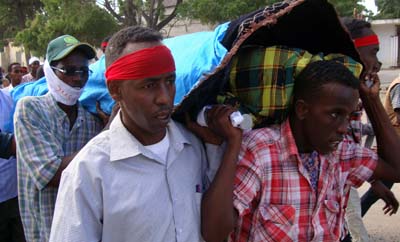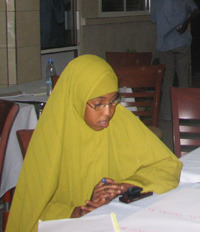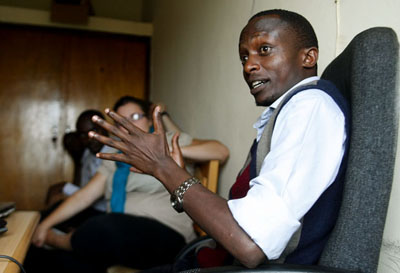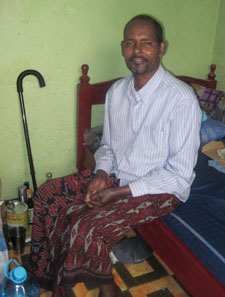Crisis in East Africa
Fifty-seven journalists fled their country in the past year, with Somalia sending the greatest number into exile. Journalists also fled Ethiopia, Eritrea, and Rwanda–mostly for Kenya and Uganda. Exiles in East Africa must grapple with poverty and fear. A CPJ special report by María Salazar-Ferro and Tom Rhodes

Published June 19, 2012
NEW YORK
Twenty-year-old Horriyo Abdulkadir worked hard to become a journalist. A dedicated multitasker, she edited, produced, and presented at local Radio Galkayo in north central Somalia while corresponding for the Mogadishu-based Radio Risaale. She covered the Somali conflict, focusing on gender and humanitarian issues. Late in the afternoon of September 14, 2011, unknown assailants shot Horriyo five times as she was leaving work. “The actual attack was not the most painful moment because it happened so fast,” she said. “It was the time afterward—I was terrified.” Days later, needing further medical attention and fearing more violence, Horriyo left for Nairobi.
CPJ Blogs
• Old life gives way to new
• Fear: The heaviest price
• Q&A with Nadira Isayeva
Video report
• Journalists in Exile
In print
• Download the pdf
In other languages
• Spanish
• French
Data
• Exiled in past year
• Exiled since 2007
Since June 2011, seven journalists have fled Somalia—making it the country with the highest number of journalists forced into exile in this 12-month period. It is closely followed by conflict-ridden Syria and Pakistan. Three other East African countries—Ethiopia, Eritrea, and Rwanda—also rank among the top 10. In fact, while the global number of journalists going into exile has decreased to 57 cases from 67 in the previous period, the proportion of East African exiles remains steady. More than a quarter of those who fled their homes from June 2011 to May 2012 came from an East African nation.
A majority of exiled journalists, like Horriyo, cited fear of violence as their reason for leaving; some fled after being attacked. (Their fears are justified; in Somalia, for example, six journalists have been killed in 2012, and no journalist murders have been prosecuted since 1992.) Others fled threats of prison and judicial harassment, common in Ethiopia and Rwanda, according to CPJ research. While reasons for fleeing into exile vary, the results are universal: Exiled journalists are subject to fear, poverty, and uncertainty, while conditions for free expression deteriorate in the countries they leave behind.
Zerihun Tesfaye, the 29-year-old senior political reporter for the critical Ethiopian weekly Addis Neger, is among the 49 Ethiopian journalists forced into exile over the past five years. He and almost all of the paper’s news staff left in December 2009, closing the publication. In July of that year, a new anti-terrorism law criminalized any reporting deemed to “encourage” or “provide moral support” to groups labeled terrorists. A government paper accused Addis Neger of making false “anti-state” allegations, and having ties to banned opposition groups. “When we heard the government was trying to charge our reporters and editors using the anti-terror proclamation, we decided to flee,” Zerihun said. In 2011, 11 independent journalists were charged under the law—six in absentia, because they are in exile.

In neighboring Eritrea, Africa’s leading jailer of journalists, 28 remain behind bars. Ten were arrested during a 2001 crackdown. In December that year, Aaron Berhane and Semret Seyoum, staffers for the biweekly Setit, and a fixer were ambushed and shot at while trying to cross into Sudan. “I thought it was the end of my life,” Aaron said. “But I preferred to die than be tortured and reveal my sources, so I ran.” Aaron made it into Sudan, then Kenya, and eventually went on to Canada. Semret and the fixer were detained. Semret, released a year later, fled to Sweden. No one has heard from the fixer since.
In Sudan, Aaron was terrified by the rumored presence of Eritrean security forces said to kidnap refugees. Other exiled journalists, including Iranians in Iraq and Turkey, have expressed similar fears. These are also common among those living in Kenya and Uganda, the two hubs for exiled East African journalists—Kenya hosts 52 exiles, Uganda 24, by CPJ’s count.
Rwandans Charles Kabonero, Richard Kayigamba, and Didas Gasana fled in 2009 to Kampala. At home, they had worked for the independent weekly Umuseso. The journalists say they were harassed from the time they launched the website The Newsline in the summer of 2010. Local police warned them that unidentified individuals carrying Kabonero’s photo had been arrested, and that as a precaution they should stop writing. Weeks later, a Rwandan official gave a European diplomat, who had hosted them for dinner, minute details of the journalists’ activities. “At that point,” said Kabonero, “it became evident that we were being followed.” The journalists identified their trackers: Rwandan security officials they knew from Kigali. Then, in August 2011, Kayigamba and Gasana found several men outside their home. One said in Kinyarwanda, “Those are the people we are seeking.” As they ran, one of the men managed to grab Kayigamba’s T-shirt, but he got away.
In December 2011, Rwandan reporter Charles Ingabire was murdered in Kampala. He had recently launched the Inyenyeri News, a critical website popular in Rwanda and Uganda. His death—still unsolved—intensified fears among exiled journalists in Kampala and Nairobi.

Kabonero and his colleagues increased their security protocol—residing far from other Rwandans; leaving the house only for basic necessities and never doing so alone; and regularly checking in with Ugandan authorities. “We lived a really terrible life,” said Kabonero, “but it was the only life we had to live.” A month after Ingabire’s shooting, Kabonero and Gasana were resettled to Sweden by the United Nations High Commissioner for Refugees (UNHCR). Kayigamba, once a soldier in the Rwandan army, is not eligible for resettlement by the UNHCR. He said he lives in permanent fear.
Refugee process full of challenges
Exiled journalists in Nairobi are more likely to be harassed by local police. They told CPJ that officers routinely stop them and ask for bribes in exchange for not arresting them. “They go directly to your pockets,” said Abdikafar Shire, who fled Mogadishu in 2005 after repeated threats. “They don’t care about your documentation.”
Even so, documentation is essential for journalists in exile, and often hard to get. Since March 2011, refugee registration in Kenya is handled by the government’s Department of Refugee Affairs and the UNHCR. (Previously, the task had been solely managed by the UNHCR.) In Uganda, the process is handled by the office of the prime minister. In both countries, the process involves initial registration, interviews, and the eventual issue of official refugee papers that allow access to basic services such as primary education and health care.
The process in Uganda can take up to three months, said Sylvia Samanya, a protection officer at the prime minister’s office. In Kenya, the process can last up to a year and cause much anxiety. According to Ethiopian reporter Zerihun, who has been in Nairobi for more than two years, “waiting is the most frustrating thing happening in exiled life.”
In at least one case, the extended process had fatal ramifications. Veteran Somali journalist Hassan Mohamed visited the UNHCR as soon as he arrived in Nairobi in January 2011, but was told to return in 2012. A diabetic with other health complications, Hassan became seriously ill in March 2011, after months without medication that he could not get without documentation. Following several hospitalizations and a weeklong coma, Hassan died in March 2012. By then, he was a registered refugee, but the toll on his body had been taken. The UNHCR estimates that there are almost as many unregistered refugees as those who are registered in Nairobi.

Finding work is also crucial for exiled journalists. In Nairobi, refugees need an official work permit, granted by the government, which is expensive and difficult to obtain. “Very few people are able to get them,” said a UNHCR protection officer in Nairobi, who asked not to be identified per the agency’s practice. Journalists who spoke to CPJ said that hunting for other kinds of jobs is difficult because of xenophobia among host populations. A few string for local or international outlets, and many work for independent websites that do not remunerate them. Instead, journalists said they often rely on grants from international organizations like CPJ to cover basic needs.
All of these challenges are intensified by a lack of information. Many journalists said they knew nothing about the refugee process or life in exile prior to fleeing. “I had no time to ask what Nairobi life looks like. It was not my intention to be here. I just came to save my life,” Zerihun said. Journalists often lack information about refugee rights and the exact responsibilities of the UNHCR and host governments. The UNCHR protection officer said that registered refugees are handed a booklet in major local languages with this information and that the UNHCR hosts periodic forums to address questions. Mark Weinberg, a regional refugee coordinator at the U.S. Embassy in Nairobi, agreed that misinformation is a serious challenge. “No matter how much we try to get the message out there,” he said, “I fear that the rumor mill always triumphs.”
The UNHCR officer said a lot remains to be accomplished. “The main hurdle for us is that we have very few resources,” he said. Local authorities are also under-resourced, he added. For example, he said, the often overburdened local police can’t provide appropriate security for refugees while also dealing with Nairobi’s high crime rate.
High cost for exiled journalists
The journalist refugee crisis of East Africa has now spanned more than a decade, taking a serious toll on the region’s press freedom. With 14 journalists forced out of Rwanda, 27 from Eritrea, 49 from Ethiopia, and a whopping 78 out of Somalia over the past five years, the region’s media landscape is devastated, exiled journalists told CPJ. Somali reporter Abdikafar lamented that violence and exile had wiped out the country’s most professional outlets. His colleague Horriyo said that with so many journalists gone, those left to report inside the country don’t have proper training. Eritreans, Ethiopians, and Rwandans told similar stories of desolation.
All the journalists in exile share an uncertain future. While Zerihun has no hope of returning to Ethiopia, Horriyo would go back to Somalia in a heartbeat if there was peace. “When you go into exile, at first it doesn’t feel like a good thing because you’ve left everything behind,” concluded Eritrean editor Aaron. “But then you are also grateful to have a new life.”
CPJ is releasing its annual survey of journalists in exile to mark World Refugee Day, June 20. This year, CPJ cut the period in which it tracks exiles from 10 years to five, in order to effect a more complete account. CPJ’s survey counts only those journalists who fled due to work-related persecution, who remained in exile for at least three months, and whose current whereabouts and activities are known. It does not include the many journalists and media workers who left their countries for professional or financial opportunities, those who left due to general violence, or those who were targeted for activities other than journalism, such as political activism. CPJ’s survey is based solely on cases it has documented, from which it derives global trends. Other groups using different criteria cite higher numbers of journalists in exile.
Journalist Assistance Associate Sheryl A. Mendez contributed reporting.